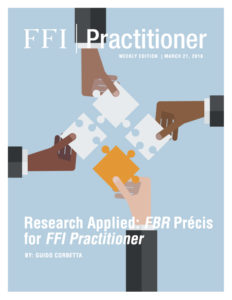
View this edition in our enhanced digital edition format with supporting visual insight and information.
In this week’s FFI Practitioner, we are pleased to share a compelling précis of “Nonfamily Members in Family Firms: A Review and Future Research Agenda” – an article that appears in the March 2018 issue of FBR. Thanks to Guido Corbetta of the FBR Research Applied Board for sharing an insightful review of the research’s key findings as well as discussing its practical implications for advisers in the field.
Introduction
The article is a review of 82 articles (all the relevant ones) published in 34 academic journals from 1989 through 2017 on nonfamily members in family firms. The authors use the term nonfamily member to refer to “any individual employed in a family firm who is not part of the owning family, regardless of title.”
Through a very analytical and well developed process the authors classify the articles in eight categories (formalization, compensation, culture, nonfamily background and attraction, justice, socialization, firm performance, and family-centered goals), and into three broad themes: pre-employment considerations, employment considerations, and employment outcomes.
Findings
Pre-employment literature review findings:
- The first nonfamily manager hired by many family firms is often the CFO, supporting the idea that improving financial management is frequently the initial target when family firms do professionalize;
- Recent research indicates nonfamily members display pro-organizational behaviors that make formalization less necessary, and that the goals of family owners and nonfamily managers are not as divergent as commonly thought;
- Some authors caution that once nonfamily members have gained idiosyncratic knowledge they may be in a position to expropriate a disproportionate share of the value a family firm creates;
- Nonfamily members of family firms tend to be paid less than employees at smaller nonfamily firms, but this finding is affected by whether the firm is professionalized and the nature of the position (nonfamily CEO pay in family firms is comparable with that of CEOs at nonfamily firms);
- Females and aspiring entrepreneurs are attracted to family firms while urban residents and highly educated or experienced individuals are disinclined to join them;
- Individuals desiring security and stability prefer family firms whereas those valuing flexibility and change do not.
Employment literature review findings:
- Although some family firms may engage in unfair treatment of nonfamily members, recent research questions whether these practices are currently widespread;
- Altruistic leader behaviour toward nonfamily members fosters their commitment to the organization, trust in leadership, and goal alignment.
Outcome findings:
- Family owners are more committed to financial performance than commonly assumed and believe a nonfamily CEO is often necessary for improved firm performance;
- The benefits of employing nonfamily CEOs is contingent on context: nonfamily CEOs at large firms or at firms with dispersed family ownership generally overperform when compared with family CEOs;
- A nonfamily CEO combined with a family chairman of the board optimizes firm performance;
- The inclusion of nonfamily managers, combined with family involvement and oversight, generally improves family firm performance due to a variety of reasons, such as:
- The perception that nonfamily members are valued may encourage nonfamily members to contribute their knowledge and ideas to strategic decision making.
- Nonfamily members may augment a family firm’s social capital and innovation.
- Nonfamily executives often provide legitimacy to the firm, which contributes to resource acquisition.
Implications for advisers and their clients
For advisers and their clients, I see three main implications of this very interesting literature review:
- All family firms need the contribution of professional nonfamily members.
- For this reason, family firms have to create an environment that will appeal to high-quality nonfamily job candidates by providing more attractive compensation packages, broader career opportunities, and greater opportunities for learning through, for example, better training.
- Family firms should select nonfamily members not only for their contribution to productivity increase (economic goal), but also for their contribution to the firm’s culture, reputation, or perceived amicability toward the business family’s continued control and influence (socioemotional goals).
About the contributor
 Guido Corbetta is Alberto Falck Chair in Strategic Management in Family Business at Bocconi University in Milan, Italy. The co- recipient of the 2014 FBR Best Article Award, he can be reached at guido.corbetta@unibocconi.it.
Guido Corbetta is Alberto Falck Chair in Strategic Management in Family Business at Bocconi University in Milan, Italy. The co- recipient of the 2014 FBR Best Article Award, he can be reached at guido.corbetta@unibocconi.it.
About Bocconi University
Università Bocconi, founded in 1902, was the first Italian university to grant a degree in economics. It offers courses in strategic management of family businesses that provide students, family business members, and professionals the opportunity to discuss relevant cases and topics with testimonials from distinguished owning families.
Newsflash:
We are pleased to announce that the award for the Best Article published in FBR in 2017 has been given to Daniel Holt and Kristen Madison from Mississippi State University and Franz Kellermanns from University of North Carolina at Charlotte, for their article “Variance in Family Members’ Assessments: The importance of dispersion modeling in family firm research.” (March 2017)
The award, sponsored by Lansberg, Gersick & Associates, will be presented at the Global Education Network Awards Breakfast on Thursday morning, October 25, 2018 at the Park Plaza Riverbank in London.

Daniel Holt
Mississippi State University

Kristen Madison
Mississippi State University

Franz Kellermanns
University of North Carolina at Charlotte

View this edition in our enhanced digital edition format with supporting visual insight and information.





